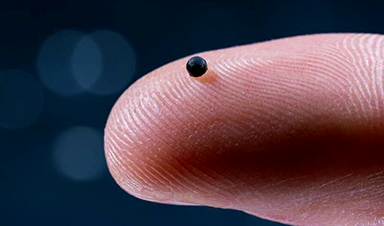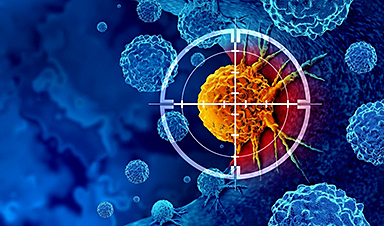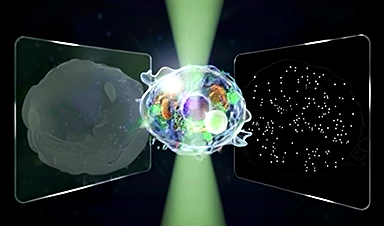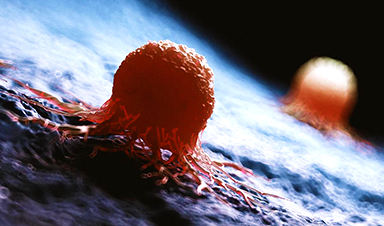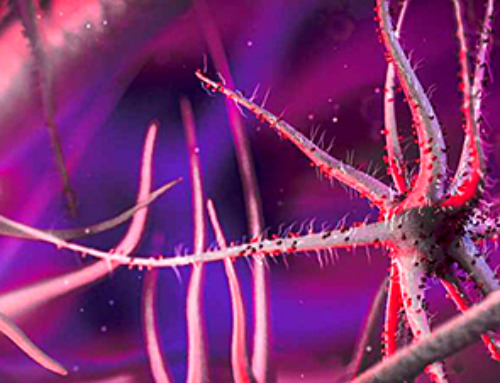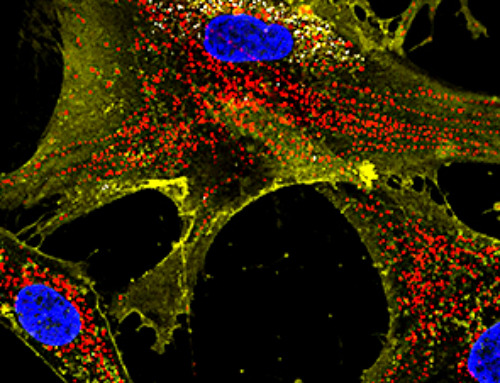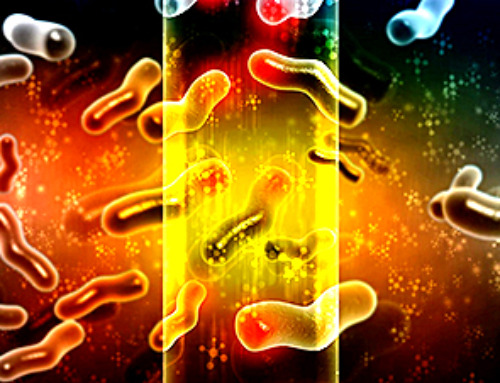- For 400 million years, a leading hypothesis claims, Earth was an "RNA World," meaning that life must've first replicated from RNA before the arrival of proteins and DNA.
- Unfortunately, scientists have failed to find evidence of this "first replicator" or recreate the replication process in the lab under the conditions that conceivably would have been present on the planet billions of years ago.
- In a new study, using three-letter "triplet" RNA, scientists induced RNA replication by preventing the RNA double helix from zipping together.
Where did we all come from? It's a question that has lit fires of curiosity in philosophers, theologians, and more recently (at least, historically speaking) scientists for millennia. While the the older guard of high thought used stories or metaphors to derive life's origin story, scientists instead learn about the inner workings of life's smallest building blocks in an attempt to understand how they first formed life billions of years ago.
This long scientific exploration has led most evolutionary biologists to the conclusion that, for at least 400 million years, Earth was an "RNA World." The hypothesis suggests that life first took form due to self-replicating RNA, before the evolutionary arrival of DNA or even proteins.
But there's a couple problems.
First, there's no trace of this "first replicator" in known biology. And second, scientists have failed to convincingly replicate RNA in an environment similar to early Earth. While scientists are very much still on the hunt for evidence that validates the first of these two issues, a team from University College of London (UCL) is closing in on solving the second problem.
Published in the journal Nature Chemistry, a team of UCL scientists (along with experts from the MRC Laboratory of Molecular Biology in Cambridge) used three-letter "triplet" RNA building blocks subjected to acid and heat in water. This separated the RNA double-helix—the structure that makes replication so difficult—and scientists froze the solution.
What occurred next is possibly an intimate glimpse of how life first formed on Earth—between the liquid gaps of the ice crystals, these building blocks coated the RNA strands and prevented them from zipping back together. After the scientists thawed the solution and and made adjustments to pH and temperature, the RNA replicated again and again. Eventually, the strand was so long that these structures could perform biological functions.
"The triplet or three-letter building blocks of RNA we used, called trinucleotides, do not occur in biology today, but they allow for much easier replication. The earliest forms of life are likely to have been quite different from any life that we know about," James Attwater, lead author of the study from UCL, said in a press statement. "The changing conditions we engineered can occur naturally, for instance with night and day cycles of temperature, or in geothermal environments where hot rocks meet a cold atmosphere."
UCL has long been involved in constructing the play-by-play of life's origins on Earth. In 2017, for example, a study analyzed the chemistry that provided Earth with the very nucleotides necessary to construct the first RNA structures. This new study now attempts to understand, in a lab setting, how those ancient RNA first began replication, a process that's essential to understanding the foundation of life.
"Life is separated from pure chemistry by information, a molecular memory encoded in the genetic material that is transmitted from one generation to the next," Philipp Holliger, the senior author of the study from MRC Laboratory of Molecular Biology, said in a press statement. "For this process to occur, the information must be copied, i.e. replicated, to be passed on."
Currently, the researchers have only been able to replicate roughly 17 percent of the RNA strand (roughly 30 out of 180 letters), but the team says there's no reason they won't achieve complete replication with improved enzyme efficiency. The researchers also note that this reaction can't occur in saltwater (the salt disrupts the freezing process), but geothermal freshwater lakes or ponds would be the perfect chemical setting for RNA replication to take hold.
Although many questions remain, Earth's ancient RNA World could have actually had the capacity for self-replication. It's an intriguing step forward, but the scientific journey continues.
News
Novel mRNA therapy curbs antibiotic-resistant infections in preclinical lung models
Researchers at the Icahn School of Medicine at Mount Sinai and collaborators have reported early success with a novel mRNA-based therapy designed to combat antibiotic-resistant bacteria. The findings, published in Nature Biotechnology, show that in [...]
New skin-permeable polymer delivers insulin without needles
A breakthrough zwitterionic polymer slips through the skin’s toughest barriers, carrying insulin deep into tissue and normalizing blood sugar, offering patients a painless alternative to daily injections. A recent study published in the journal Nature examines [...]
Multifunctional Nanogels: A Breakthrough in Antibacterial Strategies
Antibiotic resistance is a growing concern - from human health to crop survival. A new study successfully uses nanogels to target and almost entirely inhibit the bacteria P. Aeruginosa. Recently published in Angewandte Chemie, the study [...]
Nanoflowers rejuvenate old and damaged human cells by replacing their mitochondria
Biomedical researchers at Texas A&M University may have discovered a way to stop or even reverse the decline of cellular energy production—a finding that could have revolutionary effects across medicine. Dr. Akhilesh K. Gaharwar [...]
The Stunning New Push to Protect the Invisible 99% of Life
Scientists worldwide have joined forces to build the first-ever roadmap for conserving Earth’s vast invisible majority—microbes. Their new IUCN Specialist Group reframes conservation by elevating microbial life to the same urgency as plants and [...]
Scientists Find a Way to Help the Brain Clear Alzheimer’s Plaques Naturally
Scientists have discovered that the brain may have a built-in way to fight Alzheimer’s. By activating a protein called Sox9, researchers were able to switch on star-shaped brain cells known as astrocytes and turn them into [...]
Vision can be rebooted in adults with amblyopia, study suggests
Temporarily anesthetizing the retina briefly reverts the activity of the visual system to that observed in early development and enables growth of responses to the amblyopic eye, new research shows. In the common vision [...]
Ultrasound-activated Nanoparticles Kill Liver Cancer and Activate Immune System
A new ultrasound-guided nanotherapy wipes out liver tumors while training the immune system to keep them from coming back. The study, published in Nano Today, introduces a biodegradable nanoparticle system that combines sonodynamic therapy and cell [...]
Magnetic nanoparticles that successfully navigate complex blood vessels may be ready for clinical trials
Every year, 12 million people worldwide suffer a stroke; many die or are permanently impaired. Currently, drugs are administered to dissolve the thrombus that blocks the blood vessel. These drugs spread throughout the entire [...]
Reviving Exhausted T Cells Sparks Powerful Cancer Tumor Elimination
Scientists have discovered how tumors secretly drain the energy from T cells—the immune system’s main cancer fighters—and how blocking that process can bring them back to life. The team found that cancer cells use [...]
Very low LDL-cholesterol correlates to fewer heart problems after stroke
Brigham and Women's Hospital's TIMI Study Group reports that in patients with prior ischemic stroke, very low achieved LDL-cholesterol correlated with fewer major adverse cardiovascular events and fewer recurrent strokes, without an apparent increase [...]
“Great Unified Microscope” Reveals Hidden Micro and Nano Worlds Inside Living Cells
University of Tokyo researchers have created a powerful new microscope that captures both forward- and back-scattered light at once, letting scientists see everything from large cell structures to tiny nanoscale particles in a single shot. Researchers [...]
Breakthrough Alzheimer’s Drug Has a Hidden Problem
Researchers in Japan found that although the Alzheimer’s drug lecanemab successfully removes amyloid plaques from the brain, it does not restore the brain’s waste-clearing system within the first few months of treatment. The study suggests that [...]
Concerning New Research Reveals Colon Cancer Is Skyrocketing in Adults Under 50
Colorectal cancer is striking younger adults at alarming rates, driven by lifestyle and genetic factors. Colorectal cancer (CRC) develops when abnormal cells grow uncontrollably in the colon or rectum, forming tumors that can eventually [...]
Scientists Discover a Natural, Non-Addictive Way To Block Pain That Could Replace Opioids
Scientists have discovered that the body can naturally dull pain through its own localized “benzodiazepine-like” peptides. A groundbreaking study led by a University of Leeds scientist has unveiled new insights into how the body manages pain, [...]
GLP-1 Drugs Like Ozempic Work, but New Research Reveals a Major Catch
Three new Cochrane reviews find evidence that GLP-1 drugs lead to clinically meaningful weight loss, though industry-funded studies raise concerns. Three new reviews from Cochrane have found that GLP-1 medications can lead to significant [...]









